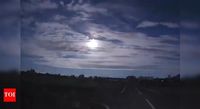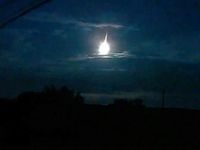Residents across southern Japan were treated to a breathtaking cosmic spectacle late on August 19, 2025, as a brilliant fireball streaked across the night sky, briefly turning darkness into daylight and sparking a wave of awe, speculation, and scientific curiosity. The event, which occurred at 11:08 p.m. local time, was so intense that it was captured on countless dashcams and surveillance cameras, with footage quickly making the rounds on social media and news outlets nationwide.
For many, the experience was nothing short of unforgettable. According to reports compiled by BBC and local Japanese media, the fireball blazed a path southwest above cities such as Kagoshima and Kumamoto, its vivid green-blue light visible from hundreds of miles away. In fact, the meteor’s brightness was so extraordinary that it was also spotted as far east as Osaka’s Kansai Airport, some 200 kilometers from the initial sighting. As one dashcam video from a motorist in Kumamoto City’s Kita Ward shows, the sky lit up dramatically, casting sharp shadows and briefly revealing the outlines of buildings as if it were midday.
Yoshihiko Hamahata, a resident driving through Miyazaki prefecture at the time, described the moment with palpable astonishment: “A white light I had never seen before came down from above, and it became so bright that I could clearly see the shapes of the houses around us.” He went on to add, “It seemed like daylight. For a moment, I didn’t know what had happened and was very surprised.” Hamahata’s reaction echoed the feelings of many who witnessed the event, some of whom even wondered if they were witnessing an alien invasion rather than a natural celestial phenomenon.
But what exactly caused this spectacular display? According to Toshihisa Maeda, head of the Sendai Space Museum in Kagoshima Prefecture, the phenomenon was a fireball—an exceptionally bright meteor that occurs when a space rock, typically a fragment of an asteroid or comet, enters Earth’s atmosphere at high speed and burns up due to friction. “This was an exceptionally bright meteor, with brightness compared to the Moon,” Maeda explained, aiming to reassure the public and dispel any fears about the event’s origins. He further noted that while most meteors disintegrate before making contact with the ground, larger fragments, like the one observed, can sometimes survive the descent, though in this case, it was likely that the meteor broke apart and crashed harmlessly into the Pacific Ocean.
Experts estimate that the meteor responsible for the August 19 fireball exceeded a size of one meter, making it a relatively large space rock by meteor standards. The scale and intensity of the event were underscored by the fact that the fireball’s brightness temporarily overwhelmed some camera sensors, and its final moments were marked by a burst of orange-red light as it broke apart near the horizon. According to NHK, Japan’s public broadcaster, the country frequently records such fireball sightings thanks to its active meteor-monitoring networks and generally clear skies—factors that make Japan an ideal spot for both professional and amateur skywatchers.
For those less familiar with the science behind such events, meteors—often called “shooting stars”—are actually bits of space debris left over from the formation of the solar system. When these particles, which can range from tiny grains to large rocks, enter Earth’s atmosphere at tremendous speeds, they encounter fierce friction with the air. This friction causes them to heat up and burn, creating the bright streak of light that observers on the ground can see. Larger fragments that glow especially brightly are called fireballs, and they can outshine even the brightest planets in the night sky.
The timing of the August 19 fireball added another layer of intrigue. At the time, two meteor showers were active—the Perseids, famous for producing dazzling fireballs, and the weaker kappa Cygnids. However, as reported by the Japan Times, it remains unclear whether this particular fireball was linked to either of these showers or if it was simply a sporadic meteor, a random piece of space debris making its fiery descent to Earth. Regardless of its origin, the event served as a vivid reminder of the dynamic activity constantly unfolding in our solar system, with Earth regularly intersecting the paths of ancient cosmic fragments.
Japan’s enthusiasm for celestial events is well documented, and the country’s robust network of meteor-monitoring systems means that such phenomena are often recorded and analyzed in remarkable detail. According to the Sendai Space Museum, fireballs are not an everyday occurrence, but they are not exceedingly rare either. Still, the sheer brightness and visibility of the August 19 event set it apart from routine sightings, captivating both scientists and the general public alike.
For some, the fireball was a cause for concern—especially given its intensity and the initial uncertainty about its nature. Social media buzzed with speculation, and some skywatchers admitted to fleeting worries about extraterrestrial visitors. Yet, as official statements from space specialists made clear, there was never any threat to residents’ safety. “This meteor might have crashed into the Pacific Ocean and was no threat to the residents’ lives,” Maeda assured the public, emphasizing that such events are natural and generally harmless.
The fireball’s passage over Japan also sparked renewed interest in the science of meteors and meteor showers. As the Perseid meteor season approached, many amateur astronomers and curious onlookers were reminded of the wonders that await those who keep an eye on the night sky. The event served as a timely prompt for both education and inspiration, highlighting the importance of scientific observation and the enduring human fascination with the cosmos.
In the end, the August 19 fireball was more than just a fleeting spectacle—it was a vivid demonstration of Earth’s ongoing relationship with the wider universe, a reminder that even in our modern, illuminated cities, the mysteries of space can still surprise and delight us. For those who happened to look up that night, it was a moment of wonder they are unlikely to forget.

